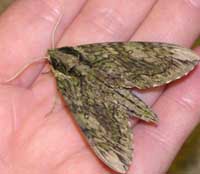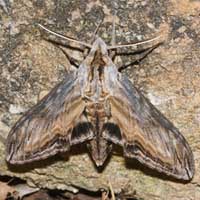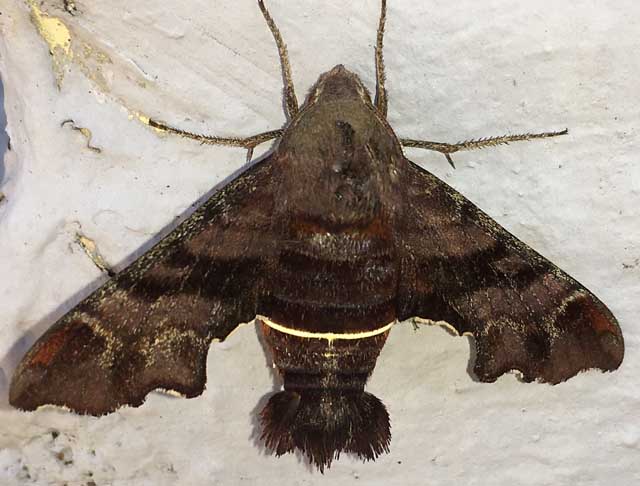Sphinginae subfamily
Sphingini tribe:
 |
Agrius cingulata,
Pink-spotted hawkmoth; Blount,
possible but unlikely stray
This species is a strong migrant and adults nectar from
deep-throated flowers including moonflower (Calonyction aculeatum),
morning glory (Convolvulus), honey suckle (Lonicera)
and petunia (Petunia species).
|
 |
Ceratomia amyntor,
the Elm Sphinx or Four-horned Sphinx
The upperside of the forewing is brown with dark brown and white markings including a white costal area near the wing base, dark streaks along the veins,
and a white spot in the cell.
Larvae feed on Elm (Ulmus), birch (Betula), basswood (Tilia), and
cherry (Prunus). |

|
The upperside of the forewing is yellowish brown with no white markings, but there are indistinct black lines and dashes. The cell spot is gray with a black outline. The larvae feed in large groups and are much more
spectacular than the moths.
Catalpa is the larval host.
|
 |
Ceratomia hageni,
the Hagen's Sphinx or Osage Orange Sphinx
The upperside of the forewing is gray with a green tint and has dark indistinct wavy lines, and pale gray patches at the wing tip and along the costa.
|
 |
The upperside of the forewing is pale brownish gray with wavy black
and white lines and a black-outlined white cell spot. The upperside
of the hindwing is gray with diffuse darker bands.
|
 |
Dolba hyloeus
WO, the Pawpaw Sphinx; Anderson
The upperside of the forewing is dark brown with a dusting of white
scales. Some moths have patches of reddish or yellowish brown on the
wings.
|
 |
The upperside of the forewing is gray with heavy black bands. The upperside of the hindwing is brownish gray with no markings.
The underside is rather plain.
|
 |
The upperside is of the forewing is gray with two
(sometimes one or three) black dashes near the wing center;
other markings are usually diffuse. The upperside of the
hindwing is a uniform brown-gray.
If you've got pines, this species is
possibly
present. |
 |
The upperside of the forewing is gray-brown with wavy lines, black
dashes, and one or two small white spots near the center of the
costa. The upperside of the hindwing is black with two white bands
and a triangular black patch at the base. Note the golden hair on the
thorax.
|
 |
The upperside of forewing is gray to grayish brown with a black line
running from the middle of the costa to the middle of the outer
margin; the line may be broken near the margin. There is a splash of
brown around the cell spot.
|
 |
I suspect if you grow tomatoes, you are likely to encounter Manduca quinquemaculata.
|
 |
Manduca rustica, the Rustic Sphinx; Knox/Sevier
Look for three large yellow spots
on each side of the abdomen. The upperside of the forewing is
yellowish brown to deep chocolate brown with a dusting of white
scales and zigzagged black and white lines. unlikely
|
 |
Manduca sexta, the Carolina Sphinx; Knox/Grainger/Blount
If you grow tomatoes, you have probably encountered Manduca sexta
in the larval stage.
Larvae get very large and can strip a tomato plant.
|
 | The upperside of the forewing is gray with indistinct black and
white markings. There is a series of black dashes
from the base to the tip, and a small white cell spot.
|

|
Sphinx canadensis,
Sphinx canadensis, the Canadian Sphinx, is not common, and is not
often reported anywhere,
but it might be present in Licking County.
Larval hosts are white ash (Fraxinus americana) and blueberry
(Vaccinium).
|
 |
Sphinx chersis, the Northern Ash Sphinx or Great Ash Sphinx
Larval hosts are ash,
lilac, privet, cherry, and quaking aspen.
|
 |
We have them
on P.E.I., but I do not see them nearly as frequently
as I see the other Sphingidae.
|
 |
Sphinx franckii, Franck's Sphinx Moth; /Anderson
This species is not widely reported anywhere. Similar to
S. kalmiae but lacks the dark bar
along the forewing inner margin.
|
 |
Sphinx kalmiae, the Laurel Sphinx; /Anderson
The lower forewings are predominantly brownish-yellow with a fairly
wide dark bar along the inner margin. At rest the wings hug the body,
giving the moth a long slender look.
|
Smerinthini Tribe:
 |
Amorpha juglandis,
the Walnut Sphinx; Knox/Blount/Roane//Anderson
The adults are also highly variable; sometimes wings of an individual
may be all one color or may have several colors, ranging from pale to
dark brown, and may have a white or pink tinge. Patterns range from
faint to pronounced.
See the file for the female; she is different. |
 |
This moth has a large, heavy body, and females can be remarkably
plump.
|
 |
Paonias astylus, the
Huckleberry Sphinx; Sevier/Anderson
This appears to be an uncommon species.
The forewing outer margin is relatively straight in this species, lacking the scalloping found in P. excaecata
or the protrusions of P. myops.
|
 |
Paonias excaecata,
the Blinded Sphinx; Sevier/Anderson
Named for the dull grey-blue spot (minus dark pupil) in the hindwing,
this moth has a wide distribution in the eastern United States.
I regularly see them on Prince Edward Island, and they are reported
as far south as Florida. |
 |
Paonias myops, the Small-eyed Sphinx; Knox/Anderson
Named for the small eye-spot in the hindwing, this moth has a wide
distribution and is probably common in Licking County.
I regularly see them on Prince Edward Island, and they are reported
as far south as Florida.
|
 |
This moth is widely distributed and fairly common.
Along the East Coast, it flies from P.E.I. to Florida.
|
Macroglossinae subfamily
Dilophonotini tribe:
See Hemaris comparison to help distinguish
the next two species.
 |
Hemaris thysbe, the Hummingbird Clearwing; Union/Anderson
It is not difficult to see why many gardeners would mistake an
Hemaris thysbe moth for a small hummingbird as it hovers,
sipping nectar from flowers through a long feeding tube.
|
 |
Hemaris diffinis, the
Snowberry Clearwing or Bumblebee Moth; Knox/Grainger/Jefferson/Roane/Anderson
Adults mimic bumblebees and are quite variable. The wings are basically clear, with dark brown to
brownish-orange veins, bases and edges. The thorax is golden-brown to
dark greenish-brown. The abdomen tends to be dark (black) with 1-2
yellow segments before the tip.
|
Philampelini tribe:
 |
Larvae get large and feed on grape vines and Virginia creeper.
Note the differences between this moth and the Pandorus Sphinx. |
 |
Eumorpha pandorus, the Pandorus Sphinx; Knox/Loudon//Anderson
If you have Grape or Virginia Creeper nearby, then you probably have
this species.
I often get asked to identify larvae from areas not
previously reported. |
Macroglossini tribe:
 |
Amphion floridensis,
the Nessus Sphinx; D&CJ/Claiborne/Roane//Anderson
This day flier is widely distributed. If you have Virginia Creeper, you
probably have the Nessus Sphinx. Two bright, distinct, narrow yellow
bands are often visible on the abdomen.
|
Amphion floridensis, Knoxville, Knox County, April 24, 2019, Donna & Clell Jenkins.
 |
The lower wings of this hawkmoth are a solid brownish-orange,
matching the body colour.
You will often see this species listed as Darapsa pholus,
especially in older literature.
|
 |
Darapsa myron, the Virginia Creeper Sphinx or the Grapevine Sphinx; Knox/
Sevier/Anderson
If you have the
foodplants indicated in the common names, you probably have this
species nearby. The lower wings are orange.
|
 |
If you have hydrangea growing near a stream, then you might have the
Hydrangea Sphinx.
|
 |
Deidamia inscriptum,
the Lettered Sphinx; Knox/Blount/Loudon/Anderson
The moth's outer margin of the forewing is deeply scalloped.
The upperside is light brown with dark brown markings.
There is a small black and white spot near the tip.
Grape (Vitis), ampelopsis (Ampelopsis), and Virginia creeper
(Parthenocissus) all serve as larval hosts.
|
 |
Hyles lineata, the White-lined Sphinx; Knox/
This species has
strong migrating tendancies from much further south.
There are records from New Hampshire and Maine. |
 |
This moth is very much under reported across the United States. It
is a rapid day flier so is probably not in too many collections.
Grape is a popular larval host.
|
 |
Xylophanes tersa,
the Tersa Sphinx; Knox/Anderson
The upperside of the forewing is pale brown with lavender-gray at the
base and has dark brown lengthwise lines throughout. The upperside of
the hindwing is dark brown with a band of whitish, wedge-shaped marks.
|
|
|


